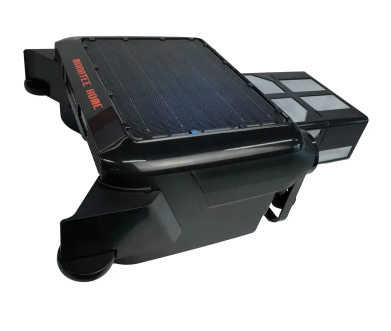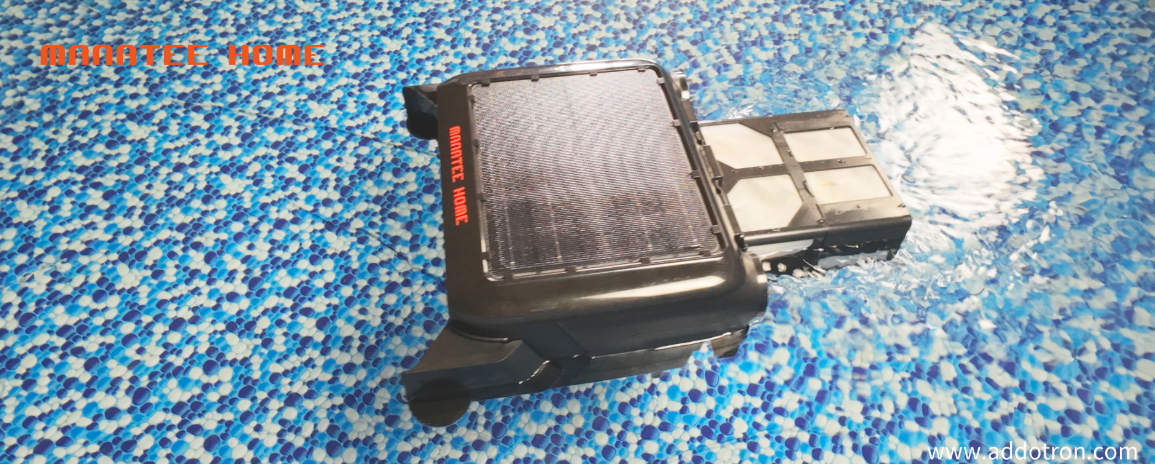Views: 0 Author: Site Editor Publish Time: 2025-09-22 Origin: Site











Owning a swimming pool is a joy. But keeping it clean can feel like endless work. Leaves drift in, dirt sinks to the bottom, and algae start to grow. That’s where robotic pool cleaners step in.
People often ask: How does a robotic pool cleaner work? The answer is a mix of smart engineering, clever sensors, and self-contained cleaning systems. Unlike older cleaners, these machines run independently from your pool pump. They scrub, vacuum, and filter water—all at once.
This guide explains exactly how robotic pool cleaners operate, why they’re so effective, and how you can get the best from them.
Self-contained motor system
Independent filter basket
Programmable cleaning cycles
Advanced navigation sensors
Energy-efficient operation
They’re built for convenience, and that’s why they’ve become the preferred option for many pool owners.

The cleaning cycle of a robotic pool cleaner may appear simple from the outside, but inside, it utilizes multiple coordinated systems to ensure every inch of your pool is thoroughly cleaned. Understanding how these systems work together can provide valuable insights into the efficiency and effectiveness of robotic pool cleaners.
A robotic pool cleaner is a complex yet highly efficient machine, powered by a series of interconnected components that work together seamlessly. Here’s a closer look at the key components:
Drive Motor: The drive motor is the heart of the cleaner, powering wheels or tank - like tracks. These propulsion systems allow the cleaner to move smoothly across the pool floor, walls, and steps, ensuring comprehensive coverage. The motor’s efficiency and durability are crucial for consistent performance.
Rotating Brushes: These brushes play a vital role in scrubbing away algae and loosening sticky grime. They rotate rapidly, breaking up dirt and debris, making it easier for the vacuum intake to collect it. The brushes are designed to reach into corners and crevices, ensuring a thorough clean.
Vacuum Intake: The vacuum intake is responsible for sucking in dirt, sand, and insects. It creates a powerful suction that draws debris into the cleaner, where it is stored in a filter basket. This component ensures that even the smallest particles are removed from the pool, maintaining water clarity.
Filtration Unit: The filtration unit captures fine dust, pollen, and hair, ensuring that the water remains clear and clean. It works in conjunction with the vacuum intake to remove even the tiniest particles, preventing them from re-entering the pool water.
Sensors: Advanced sensors detect pool walls, stairs, and the overall shape of the pool. These sensors enable the cleaner to navigate the pool efficiently, avoiding obstacles such as ladders and drains. They also help the cleaner map the pool’s layout, ensuring that every area is covered without missing any spots.
Control Unit: The control unit allows you to program schedules or connect via smartphone apps. This feature provides flexibility and convenience, enabling you to customize cleaning cycles to suit your needs. Some models even offer remote monitoring and control, allowing you to start, stop, and adjust settings from anywhere.
Each of these components plays a crucial role in ensuring that your pool is cleaned thoroughly and efficiently. The combination of powerful motors, effective brushes, and advanced sensors creates a seamless cleaning experience.
The cleaning process of a robotic pool cleaner is a well-coordinated sequence of actions. Here’s a detailed look at each step:
When you connect the control unit, the robotic cleaner sinks to the bottom of the pool. The power supply activates, initiating the cleaning cycle. This step ensures that the cleaner is fully submerged and ready to begin its task. The cleaner’s design allows it to start working immediately upon activation, making the process seamless and efficient.
As the cleaner begins its journey, advanced sensors scan the pool’s depth and layout. These sensors detect walls, stairs, and other obstacles such as ladders and drains. The cleaner uses this information to create a map of the pool, ensuring that it navigates efficiently and covers every area without missing any spots. This mapping process helps the cleaner avoid unnecessary paths and ensures comprehensive coverage.
The cleaner’s wheels or tracks grip the pool surfaces, allowing it to move smoothly across the floor, walls, and steps. This movement is powered by the drive motor, which ensures consistent and efficient propulsion. The cleaner’s design allows it to climb and maneuver over various surfaces, ensuring comprehensive coverage. The drive motor’s efficiency is crucial for maintaining consistent movement and ensuring that the cleaner can tackle different pool layouts.
During the cleaning process, the rotating brushes scrub the pool surfaces vigorously. These brushes rotate rapidly, breaking up algae and loosening sticky grime. This action ensures that even the most stubborn dirt is removed, making it easier for the vacuum intake to collect it. The brushes are designed to reach into corners and crevices, ensuring a thorough clean.
The vacuum ports on the cleaner suck in debris, storing it inside a filter basket. The filtration unit captures fine dust, pollen, and hair, ensuring that even the smallest particles are removed from the pool. This step ensures that the water remains clear and clean, preventing the buildup of debris. The filtration unit plays a crucial role in maintaining water quality and ensuring that the pool remains hygienic.
As the cleaner moves through the pool, clean water is released back into the pool. This process helps improve water circulation and balance, ensuring that the entire pool benefits from the cleaning process. The cleaner’s design ensures that it circulates water effectively, contributing to overall pool hygiene. This circulation helps maintain water clarity and prevents the buildup of contaminants.
This loop continues until the entire pool is covered, ensuring that every inch is thoroughly cleaned. The combination of advanced sensors, powerful motors, and efficient filtration systems makes robotic pool cleaners a highly effective solution for maintaining a clean and hygienic pool.
How do robotic cleaners compare to suction and pressure cleaners?
| Feature | Suction-Side Cleaner | Pressure-Side Cleaner | Robotic Cleaner |
|---|---|---|---|
| Power Source | Pool pump | Booster pump | Independent motor |
| Cleans Walls | No | Sometimes | Yes |
| Energy Use | Higher | Higher | Low |
| Ease of Setup | Medium | Medium | Very easy |
| Filtration System | Uses pool filter | Uses booster bag | Built-in basket |
Robotic cleaners clearly lead in efficiency, coverage, and independence.

The frequency of using a robotic pool cleaner depends on various factors, including pool usage and environmental conditions. Here are some guidelines to help you determine the optimal cleaning schedule:
During the summer months, especially if your pool is frequently used by children, family members, or guests, it is best to use the robotic pool cleaner daily. High usage can lead to a rapid accumulation of debris, such as leaves, sunscreen, and other contaminants. Daily cleaning helps maintain water clarity and prevents the buildup of dirt and algae, ensuring that your pool remains clean and inviting throughout the season.
For pools with moderate usage or those located in shaded areas, cleaning every 2–3 days is typically sufficient. Shaded pools tend to accumulate less debris due to reduced sunlight and wind exposure. This cleaning schedule helps maintain water quality and prevents the buildup of algae, while also ensuring that the pool remains clean and ready for use. Regular cleaning keeps the water clear and reduces the need for excessive chemical treatments.
During the off - season when the pool is not in regular use, it is advisable to clean it weekly. This schedule helps prevent algae from forming when the pool is idle. Algae can quickly take hold in stagnant water, leading to green or murky water and making the pool less appealing when you are ready to use it again. Weekly cleaning ensures that the pool remains in good condition and is ready for use whenever you decide to enjoy it.
After storms, it is important to use the robotic pool cleaner immediately to remove leaves, twigs, and mud that have been deposited into the pool. Storms can bring a significant amount of debris, which can clog filters and negatively impact water quality. Prompt cleaning helps maintain the pool’s cleanliness and prevents damage to the filtration system. Regularly cleaning after storms ensures that the pool remains in optimal condition and ready for use.
Yes. Most models scale walls and scrub the waterline.
Yes. Many models are saltwater safe, but check the manufacturer’s guide.
Usually between 1.5 to 3 hours, depending on pool size.
No. Once dropped in, they work automatically and shut off after the cycle.
With good care, 5–7 years is common. Premium models can last longer.
So, how does a robotic pool cleaner work? It uses smart sensors, brushes, and suction to clean every corner of your pool. Unlike traditional cleaners, it runs independently, saves energy, and improves water quality.
Whether you swim daily or just a few times a month, a robotic cleaner takes away the hassle of pool care. Add in professional service for seasonal maintenance, and you’ll always enjoy a safe, crystal-clear pool.
At Shandong Addotron Robotics Technology Co., Ltd., we specialize in designing and manufacturing advanced robotic pool cleaners tailored to different pool sizes, shapes, and environments. Through our customization process, we work closely with clients to adjust features such as filtration systems, navigation sensors, energy efficiency ratings, and smart app integration—ensuring every product matches your exact needs.
With our expertise and tailored solutions, keeping your pool spotless is no longer a chore—it’s a guarantee.